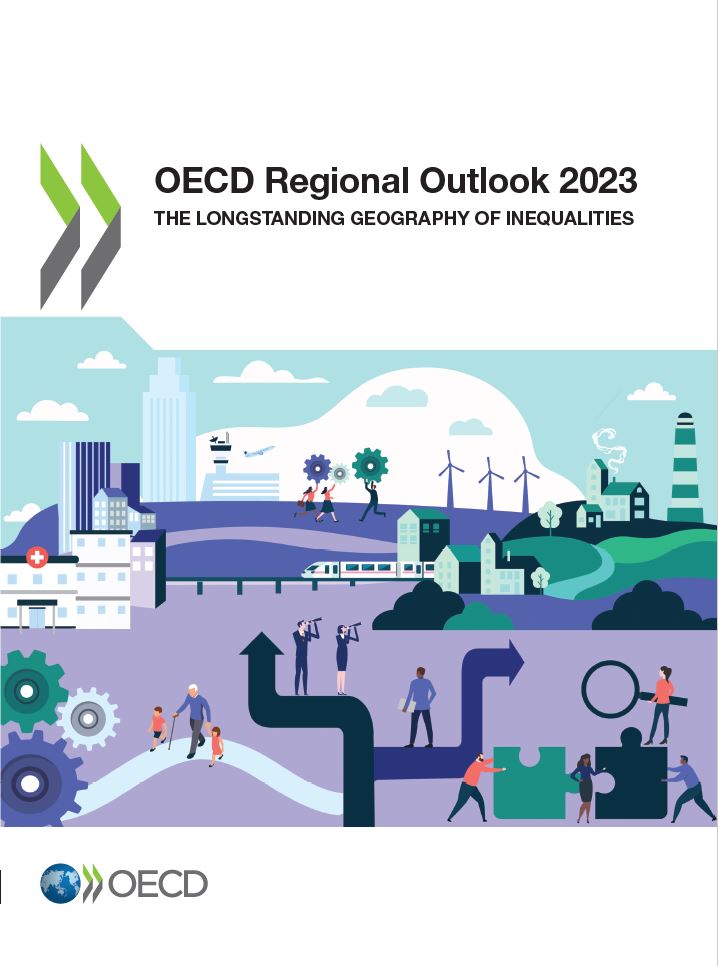Japan
| OECD Regional Outlook | |
|---|---|

|
The OECD Regional Outlook reviews recent trends, policy developments, and prospects across OECD regions, including the underlying causes driving regional inequalities in performance and well-being. The report offers evidence, guidance and policy recommendations on how to improve competitiveness and productivity, promote inclusive growth, accelerate the net-zero transition and raise well-being standards through effective regional development policy and multi-level governance. |
Overview
| Population and territory | 125 308 652 (January 1, 2022), 377,973.26km2 |
|---|---|
| Administrative structure | Unitary country |
| Regional or state-level governments | 1 Metropolis, 1 Province, 45 Prefectures |
| Intermediate-level governments | ― |
| Municipal-level governments | 1 724 Municipalities |
| Share of subnational government in total expenditure/revenues (2021) | 41.9% of total expenditure 50.3% of total revenues [Source: Subnational governments in OECD countries: key data, 2023 edition] |
| Key regional development challenges | Population decline, declining birthrate and aging population, and hollowing out of regional industries, etc. |
| Objectives of regional policy | “The Vision for a Digital Garden City Nation” aims to solve rural issues and improve rural attractiveness while utilizing strength of each region through digital technologies, and to realize a society where everyone can live conveniently and comfortably wherever they live in Japan. |
| Legal/institutional framework for regional policy | National Spatial Planning Act (1950, largely amended in 2005) |
| Budget allocated to regional development (i.e., amount) and fiscal equalisation mechanisms between jurisdictions (if any) | |
| National regional development policy framework | |
| Urban policy framework | City Planning Act (1968), Urban Renaissance Special Measures Law (2014) |
| Rural policy framework | The Basic Law on Food, Agriculture and Rural Areas (1999) The Basic Plan for Food, Agriculture and Rural Areas (2020) |
| Major regional policy tools (e.g., funds, plans, policy initiatives, institutional agreements, etc.) | National Spatial Strategy(Regional Plan) |
| Policy co-ordination tools at national level | |
| Multi-level governance mechanisms between national and subnational levels (e.g., institutional agreements, Committees, etc.) | |
| Policy co-ordination tools at regional level | |
| Evaluation and monitoring tools | |
| Future orientations of regional policy |
Regional inequality trends
Japan experienced an increase in the Theil index of GDP per capita over 2000-2020. Inequality reached its maximum in 2007. The figures are normalized, with values in the year 2000 set to 1.
The Top 20%/Mean ratio was 0.066 lower in 2020 compared to 2000, indicating decreased polarisation. The Bottom 20%/Mean ratio was 0.01 lower in the same period, indicating bottom divergence.
Note: Top/bottom calculated as population equivalent (top/bottom regions with at least 20% of the population). The interpretation of top/bottom 20% GDP per capita is that 20% of the population in the country holds 20% of the value. Top 20%/Mean calculated as mean GDP per capita in top 20% regions over mean TL3 GDP per capita in a given year. Bottom 20%/Mean calculated as mean TL3 GDP per capita in bottom 20% regions over mean TL3 GDP per capita in a given year. To improve data consistency, input series are aggregated when TL3 regions are part of the same FUA. To improve time series, TL3 missing values have been estimated based on the evolution at higher geographic level.
Source: OECD Regional Database (2022).
In 2020, the gap in GDP per capita between large metropolitan and non-large metropolitan regions was 1.13. For reference, the same value for OECD was 1.475. This gap decreased by 0.04 percentage points between 2000 and 2020.
Meanwhile, in 2020, the gap in GDP per capita between metropolitan and non-metropolitan regions was 1.101. For reference, the same value for OECD was 1.325. This gap increased by 0.001 percentage points since 2000.
In turn, the gap in GDP per capita between regions near and far a Functional Urban Area (FUA) of more than 250 thousand inhabitants was 1.045 in 2020 and increased by 0.026 percentage points since 2000.
Note: Far from a FUA>250K includes regions near/with a small FUA and remote regions. OECD mean gap based on 1 586 TL3 regions in 27 countries with available data (no TL3 data for Australia, Canada, Chile, Colombia, Costa Rica, Iceland, Ireland, Israel, Mexico, Luxembourg and Switzerland).
Source: OECD Regional Database (2022).
Recent policy developments
November 2021, Japanese PM Kishida set forth ”The Vision for a Digital Garden City Nation”, which aims to solve rural issues and improve rural attractiveness while utilizing strength of each region through digital technologies, and to realize a society where everyone can live conveniently and comfortably wherever they live in Japan. Under this vision, it is expected that the use of digital technology solves rural issues such as population decline, declining birth-rate and aging population, and hollowing out of regional industries for example by promoting remote work and relocation to rural areas, establishing satellite offices and implementing remote medicine, distance education, automated driving and drones. December 2022, the Japanese Government formulated the comprehensive strategy to realize this vision and will make a concerted effort to support the local governments in implementing measures to achieve their respective regional visions.
| Territorial definitions |
|---|
|
The data in this note reflect different sub-national geographic levels in OECD countries. In particular, regions are classified on two territorial levels reflecting the administrative organisation of countries: large regions (TL2) and small regions (TL3). Small regions are classified according to their access to metropolitan areas (Fadic et al. 2019). The typology classifies small (TL3) regions into metropolitan and non-metropolitan regions according to the following criteria:
Disclaimer: https://oecdcode.org/disclaimers/territories.html |